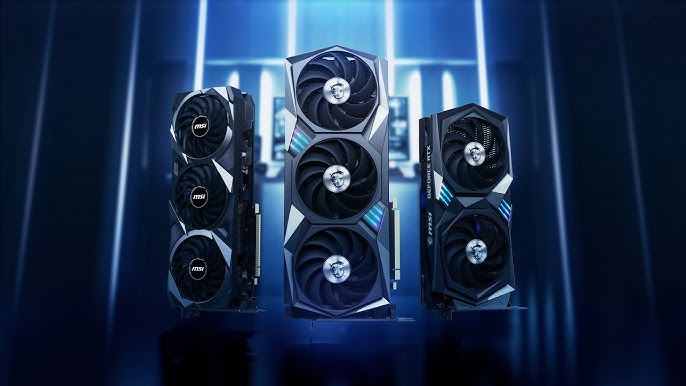MSI Afterburner author says triple fan RTX 5080 GPUs will have three independent fan controllers — Async speed control support for all three fans to arrive in an upcoming release

The creator of MSI Afterburner, Alexy Nicolaychuk dubbed "Unwinder" on the software's development forum, has confirmed that the software will see a new update close to the retail launch of Nvidia's RTX 5080. For context, the latest stable release dates back to April 2023, almost two years ago. The new update promises independent fan monitoring on triple-fan GPUs. Alexy also hints that MSI's upcoming slew of RTX 5080 offerings might integrate individual per-fan controllers for more granular control.
Controlling the speed of each fan individually requires some underlying changes on the GPU's PCB. Even across premium high-end triple-fan GPUs, many AIBs choose to connect all fans to a single header or two. So, while it is possible to independently adjust the speed of the first two fans, the third fan is fixed in relation to them.
The forum comment states that RTX 5080 GPUs (likely from MSI) provide three independent fan controllers which is a step up from the previous generations. Now that the hardware part is all sorted, software-level implementation will arrive in the form of an upcoming MSI Afterburner update near the RTX 5080's release. This indicates that the RTX 5080 will be the first Blackwell GPU to hit shelves, corroborating previous rumors of a January 21 release date. Keep in mind that not all RTX 5080 GPUs may have this feature.
Alexey says that there will be a new Afterburner button for asynchronous speed control for the third fan. With independent control over all fans, you can set custom speeds and curves for each fan, individually. The actual meaning of the second last line could be lost in translation, However, the update will likely be compatible with GPUs from other vendors as well; provided if their GPUs have three fan controllers.
Nvidia's RTX 5080 is rumored to adopt the GB203-400-A1 die outfitted with 10,752 cores or 84 SMs, 16GB of 30 Gbps GDDR7 memory, and a 256-bit memory bus. With 10% more CUDA cores than its predecessor, we can expect a moderate uplift in performance but most of that depends on how good Blackwell is, on an architectural level. As of writing, only 36 hours remain until Nvidia's keynote. We can expect a full-fledged overview of Blackwell at the event.
Get Tom's Hardware's best news and in-depth reviews, straight to your inbox.

Hassam Nasir is a die-hard hardware enthusiast with years of experience as a tech editor and writer, focusing on detailed CPU comparisons and general hardware news. When he’s not working, you’ll find him bending tubes for his ever-evolving custom water-loop gaming rig or benchmarking the latest CPUs and GPUs just for fun.
-
das_stig If you have a 30xx or 40xx, smart money says miss the 5000 unless you have to be cutting edge, performance jump, just not worth the cash NV expects to gouge from its customers.Reply -
Moonstick2 Thermally I fail to see the point. All three fans are cooling the same large heatsink, no? If it's a good thermal conductor as it should be then the thermal variation shouldn't be so much that you'll see a real advantage in blowing air harder over one third than the rest.Reply
Acoustically I can imagine three fans so close to each other but running at different and varying speeds has the potential for unpleasant or distracting effects.
Having the options for running just one fan at low speed or two fans at the same speed might make some sense maybe. -
Gillerer But the fans usually aren't cooling the same parts exactly. For example power delivery circuitry is usually located at the far end of the PCB.Reply
Not only that, the layout of the graphics card causes fans to have varying level of obstruction in their air path, so be more or less expensive acoustically to run at a given speed.
The most extreme example of that would be a thru-flow fan setup. There is a considerable advantage in being able to prioritize the fan that blows air directly out the back (instead of generating more noise from pushing against a hard obstacle). -
leclod Reply
I have a 3070 dual fan and I did follow that route to optimize fan speeds.Moonstick2 said:Thermally I fail to see the point.
I ended up with, at full load, one my fans spinning 1600rpm and the other 1000rpm.
By standard they'd both be at 1600rpm (or rather a lot more because I also undervolted)
Some rpm are wasted (but it's not a big deal) -
Moonstick2 Reply
But are there any actual significant measured differences in temperature compared to e.g. running both at 1300 rpm?leclod said:I have a 3070 dual fan and I did follow that route to optimize fan speeds.
I ended up with, at full load, one my fans spinning 1600rpm and the other 1000rpm.
By standard they'd both be at 1600rpm (or rather a lot more because I also undervolted)
Some rpm are wasted (but it's not a big deal) -
Moonstick2 Reply
But the fans cool the heatsink, which ideally is averaging or 'smearing' out the PCB temperature profile over its surface. Sure, parts of the heatsink are going to be warmer than others, but the differences shouldn't be anywhere near as pronounced as on the card itself. I can't see individual fan control on a single card, even the larger ones, as being more than a gimmick.Gillerer said:But the fans usually aren't cooling the same parts exactly. For example power delivery circuitry is usually located at the far end of the PCB.
Fans don't blow on the card, they blow on the heatsink, which can be designed for airflow however the designer sees fit. The graphics card layout doesn't cause obstruction because it's effectively insulated from the direct airflow.Gillerer said:Not only that, the layout of the graphics card causes fans to have varying level of obstruction in their air path, so be more or less expensive acoustically to run at a given speed. -
leclod Reply
Yes, last time I checked both running at 1300 rpm would result in higher temperatures if not throttling.Moonstick2 said:But are there any actual significant measured differences in temperature compared to e.g. running both at 1300 rpm?
I did set them up this way (I think). GPU under load, both fans are at 1600rpm.
Then I try to reduce each fan speed separately to see if it matters. And I end up with 1000-1600 equal to 1600-1600 (one fan more important than the other, one side of heatsink more important than the other). -
Moonstick2 Reply
1300/1300 throttles, 1000/1600 is fine? Wow.leclod said:Yes, last time I checked both running at 1300 rpm would result in higher temperatures if not throttling.
